
Firs are evergreen coniferous trees belonging to the genus Abies in the family Pinaceae. There are approximately 48–65 extant species, found on mountains throughout much of North and Central America, Europe, Asia, and North Africa. The genus is most closely related to Cedrus (cedar)The genus name is derived from the Latin "to rise" in reference to the height of its species. The common English name originates with the Old Norse, fyri, or the Old Danish, fyr.

Betula pendula, commonly known as silver birch, warty birch, European white birch, or East Asian white birch, is a species of tree in the family Betulaceae, native to Europe and parts of Asia, though in southern Europe, it is only found at higher altitudes. Its range extends into Siberia, China, and southwest Asia in the mountains of northern Turkey, the Caucasus, and northern Iran. It has been introduced into North America, where it is known as the European white birch or weeping birch and is considered invasive in some states in the United States and parts of Canada. The tree can also be found in more temperate regions of Australia.

Picea abies, the Norway spruce or European spruce, is a species of spruce native to Northern, Central and Eastern Europe.
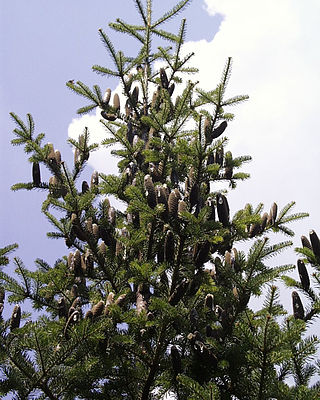
Abies balsamea or balsam fir is a North American fir, native to most of eastern and central Canada and the northeastern United States.

Salix alba, the white willow, is a species of willow native to Europe and western and central Asia. The name derives from the white tone to the undersides of the leaves.

Abies nordmanniana, the Nordmann fir or Caucasian fir, is a fir indigenous to the mountains south and east of the Black Sea, in Turkey, Georgia and the Russian Caucasus. It occurs at altitudes of 900–2,200 m on mountains with precipitation of over 1,000 mm.
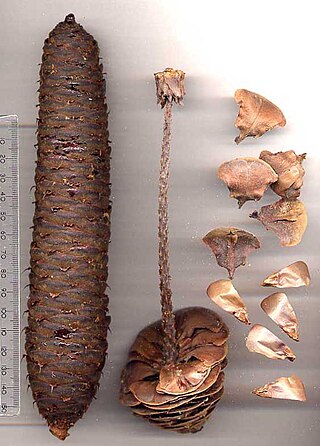
Abies borisii-regis is a species of fir native to the mountains of the Balkan Peninsula in Bulgaria, northern Greece, Kosovo, North Macedonia, Albania and Serbia. It occurs at altitudes of 800–1,800 m, on mountains with an annual rainfall of over 1,000 mm.
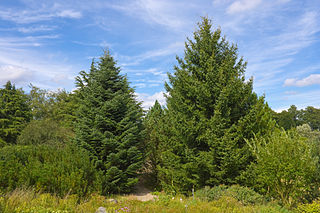
Abies cephalonica or Greek fir is a fir native to the mountains of Greece, primarily in the Peloponnesos and the island of Kefallonia, intergrading with the closely related Bulgarian fir further north in the Pindus mountains of northern Greece. It is a medium-size evergreen coniferous tree growing to 25–35 metres (82–115 ft) – rarely 40 m (130 ft) – tall and with a trunk diameter of up to 1 m. It occurs at altitudes of 900–1,700 m (3,000–5,600 ft), on mountains with a rainfall of over 1,000 millimetres (39 in).

Abies nebrodensis, the Sicilian fir, is a fir native to the Madonie mountains in northern Sicily.

Abies grandis is a fir native to northwestern North America, occurring at altitudes of sea level to 1,700 metres (5,600 ft). It is a major constituent of the Grand Fir/Douglas Fir Ecoregion of the Cascade Range.

Abies concolor, the white fir, concolor fir, or Colorado fir, is a coniferous tree in the pine family Pinaceae. This tree is native to the mountains of western North America, including the Sierra Nevada and southern Rocky Mountains, and into the isolated mountain ranges of southern Arizona, New Mexico, and Northern Mexico. It naturally occurs at elevations between 900 and 3,400 metres.

Fagus orientalis, commonly known as the Oriental beech, is a deciduous tree in the beech family Fagaceae. It is native to Eurasia, in Eastern Europe and Western Asia.
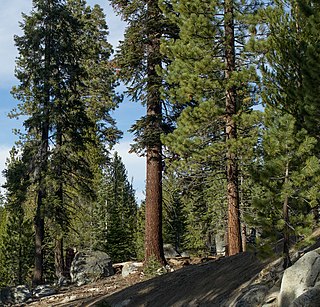
Abies magnifica, the red fir or silvertip fir, is a western North American fir, native to the mountains of southwest Oregon and California in the United States. It is a high-elevation tree, typically occurring at 1,400–2,700 metres (4,600–8,900 ft) elevation, though only rarely reaching tree line. The name red fir derives from the bark color of old trees.
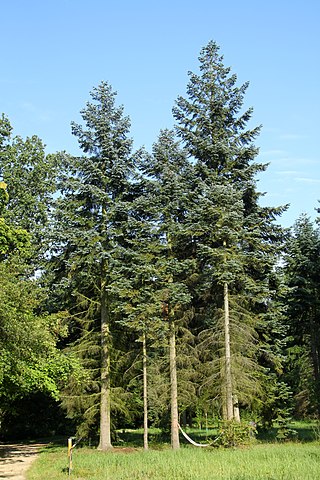
Abies procera, the noble fir, also called red fir and Christmas tree, is a species of fir native to the Cascade Range and Pacific Coast Ranges of the northwestern Pacific Coast of the United States. It occurs at altitudes of 300–1,500 meters (980–4,920 ft).

The Fraser fir, sometimes spelled" Frasier fir, is an endangered species of fir native to the Appalachian Mountains of the Southeastern United States. They are endemic to only seven montane regions in the Appalachian Mountains.

Abies lasiocarpa, the subalpine fir or Rocky Mountain fir, is a western North American fir tree.

Abies amabilis, commonly known as the Pacific silver fir, is a fir native to the Pacific Northwest of North America, occurring in the Pacific Coast Ranges and the Cascade Range. It is also commonly referred to in English as the white fir, red fir, lovely fir, amabilis fir, Cascades fir, or silver fir. The species name is Latin for 'lovely'.

Secoisolariciresinol is an organic compound. It is classified as a lignan, i.e., a type of phenylpropanoid. It is present in some cereals, such as rye, and together with matairesinol has attracted much attention for its beneficial nutritional effects.

Abies sibirica, the Siberian fir, is a coniferous evergreen tree native to the taiga east of the Volga River and south of 67°40' North latitude in Siberia through Turkestan, northeast Xinjiang, Mongolia and Heilongjiang.

Lariciresinol is a lignan, i.e., a type of phenylpropanoids. It is the precursor to enterolignans by the action of gut microflora. Enterolignans are of interest because they are speculated to exhibit beneficial medicinal properties.


























